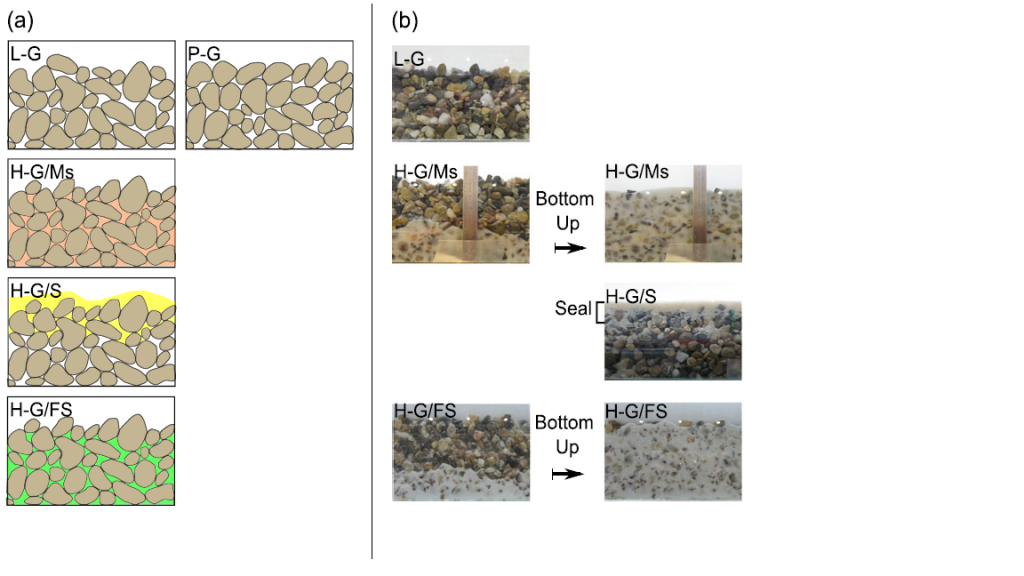Context
In mountain and piedmont hydro-systems, gravel-bed rivers often transport
large amounts of fine (silt-sized) sediments. The dynamics of such a sediment mixture is usually described as a simple superposition of fine sediment transport in suspension over a bed-load of gravel. However, the interaction between the two classes of sediment, such as hiding and exposure effects, are strong, whatever the level of the bed shear stress.
Scientific issues
- How gravel sediment transport is modified when fine sediments are present ?
- Is fine sediment impact linked to a change in the flow or a modification of bed mobility ?
- How much sand or silt effects are different ? Is it connected to their size or cohesiveness ?
Methods & Results
To cope with these issues, we choosed to work with the tilting flume of Irstea Lyon. There, we set up a gravel bed, screeded or water worked, and infiltrated with silt, fine or coarse sand.

We performed experiments and measured solid discharges and shear stress for a succesion of different water discharges.
Gravel rate was found to be impacted by the bed arrangement degree, the fine sediments concentration within the bedload layer and the changes in bed properties due the fine sediment presence (bed cohesion, bed permeability). The more packed the bed is; the more difficult it is to move gravels. The more concentrated in fine sediment the bedload layer is; the easier the transport of gravels is. The shape of fine sediments can also be an important factor for modifying the gravel rate. The presence of cohesive fine sediments within the bed matrix reduces significantly the gravel rate. A conceptual model was developed to recap the different processes controlling gravel transport. It provides a phenomenological description of the overall beds responses to a hydrograph. This tool is designed to help understanding, estimating or interpreting gravel transport in Alpine rivers. The conceptual model was discussed and applied to a field case made on the Arc River.
Using the model, we also suggest a new dimensionless analysis for the construction of a bedload predicting model involving parameters describing bed arrangement, bed properties and fine sediment presence.
Projects
- PHC FASIC 2014 FISME, Scientifc coordination : Albert Herrero, Fisme project (FIne Sediment Mass Exchange) deals with the study of fine sediment infiltration into a channel bed formed by coarser material. Its main objective is to develop a theoretical tool to quantify mass exchange of fine sediment traveling in suspension within a river flow and validate it with laboratory and field observations.
- Water agency, project in 2015 : Declog of a gravel river
PhDs and post-doctorates
- 2014-2017 : Perret Emeline, Transport of moderately sorted gravels at low bed shear stresses: impact bed arrangement and fine sediment infiltration, Université C. Bernard, Lyon 1.
- 2013-2015 : Herrero Albert, Fine sediment infiltration in a gravel bed.
Publications
Perret E., Berni C., Camenen B., Herrero A., et El Kadi Abderrezzak K. (2017) Transport of moderately sorted gravel at low bed shear stresses : the role of fine sediment infiltration. Earth Surf. Proc. Land., pages 956–962. doi : 10.1002/esp.4322.
Herrero, A. et Berni, C. (2016). Sand in ltration into a gravel bed : a mathematical model. Water Resources Research 52, p. 14. doi : 10.1002/2016WR019394.


